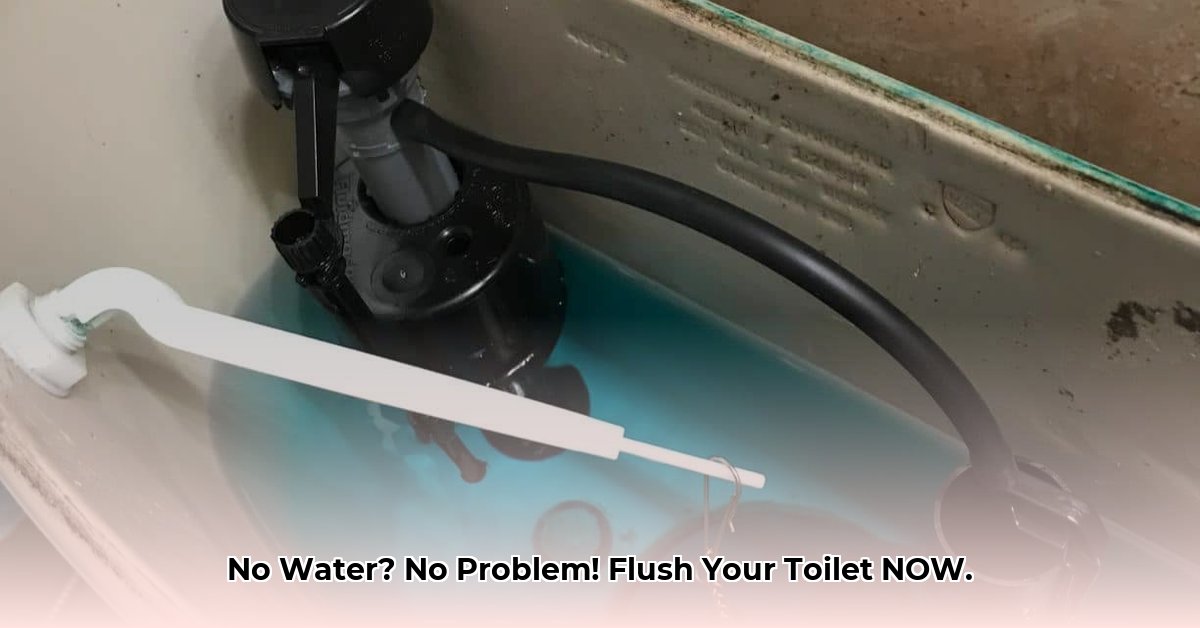No water? Don’t panic! A dry tap doesn’t mean a plumbing emergency. You can still flush your toilet, even without running water. This guide will walk you through a few surprisingly simple solutions for this common household hiccup. We’ll cover everything from the basic “bucket flush” to handling those fancy tankless toilets, plus tips on where to find that precious H2O when your faucets are dry.
Manual Flushing: Quick & Easy Solutions
Let’s dive into the how-to of flushing without running water. It’s easier than you think!
Method 1: The Bucket Brigade
This method mimics a regular flush using gravity.
- Grab Your Bucket: Any container that holds water will do—a bucket, pitcher, large bowl, even a clean wastebasket in a pinch.
- Fill ‘Er Up: Add about 1-2 gallons of water. It doesn’t need to be sparkling clean, but avoid anything too dirty.
- The Big Pour: Position yourself over the toilet bowl. Start pouring slowly, then quickly increase the pouring speed as you empty the bucket. This rush of water creates the necessary force for a successful flush.
Method 2: Tank Top-Off
If you have a traditional toilet with a tank, this method is even simpler.
- Lift the Lid: Carefully open the toilet tank.
- Fill to the Line: Fill the tank with water up to the water line (usually marked inside).
- Flush as Usual: Close the lid and flush like normal.
Method 3: Tankless Toilet Tango
Tankless toilets require a slightly different approach.
- Prepare More Water: You’ll need about 3-4 gallons for these.
- The Two-Part Pour: Slowly pour a good portion of the water directly into the bowl. Let it settle, then quickly pour the rest in to create flushing pressure. You might need to repeat this.
Finding Water: Alternative Sources
So, the faucet’s dry. Where do you find water for flushing?
- Check the Tub: Already full? Jackpot!
- Water Heater: A good source (turn it off first!).
- Rain Barrels: If you collect rainwater, you’re ahead of the game!
- Bottled Water: A last resort, but it works.
- Neighborly Love: Ask a neighbor (a plate of cookies might help!).
- Local Businesses: It’s worth a shot!
Troubleshooting: When It Doesn’t Flush
Didn’t get a successful flush? Don’t worry, it happens.
- Double-Check: Did you use enough water? Did you pour it fast enough? Did you fill the tank to the correct line?
- Plunge It: Plunging after a manual flush can help clear remaining debris.
- Soap It Up: A bit of dish soap in the water can help lubricate things.
Why No Water? Identifying the Problem
Beyond manual flushing, let’s explore why your toilet might not be getting water in the first place.
Common Culprits
- Shut-off Valve: Make sure it’s fully open (turned counter-clockwise).
- Main Water Supply: If other faucets are dry, the problem is likely with your main water supply. Check your water meter or call your local water company.
- Fill Valve Issues: This component refills the tank. A stuck float or a clog can prevent it from working correctly. Adjusting the float or cleaning/replacing the fill valve might be necessary.
- Flapper Problems: A worn or damaged flapper can cause leaks, preventing the tank from filling. Replacing the flapper is a simple fix.
- Hidden Leaks: Even a small leak can drain the tank before it fills. Inspect for moisture, cracks, or drips.
- Clogged Vent Pipe: A clogged vent can impede water flow. This usually requires a plumber.
Toilet Maintenance: Preventing Future Problems
Like any appliance, your toilet benefits from regular checkups.
- Regular Inspections: Periodically check the flapper, fill valve, and other components for wear and tear.
- Address Leaks Promptly: Even small leaks can waste water and lead to bigger problems.
- Consider a Water Softener: Hard water can cause mineral buildup, which can clog pipes and valves.
When to Call a Plumber
While DIY can be effective, sometimes it’s best to call a professional. If you’ve tried troubleshooting and your toilet is still not working, a licensed plumber can diagnose and fix more complex issues.
This guide provides general advice. Specific toilet models may have unique features or require specialized solutions. While research in toilet technology is ongoing, these tried-and-true methods are likely to remain helpful in the foreseeable future. If you are unsure about any step, consult a qualified plumber. Staying informed about your plumbing system can help ensure a smoothly flushing future!
- Contemporary Kitchen Backsplash Ideas for a Stylish Home - December 20, 2025
- Modern Kitchen Backsplash Ideas To Inspire Your Refresh - December 19, 2025
- Modern Backsplash Ideas: A Guide to Todays Kitchen Trends - December 18, 2025










